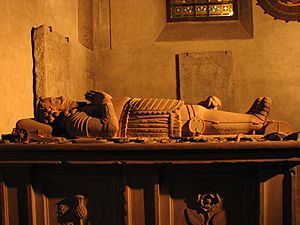Samuel Cockburn (mercenary) facts for kids
Quick facts for kids
Samuel Cockburn
|
|
|---|---|

Cockburn's tomb in Turku cathedral
|
|
| Born | 1574 Scotland |
| Died | 1621 (aged 46–47) Latvia |
| Allegiance | Sweden |
| Rank | Colonel |
| Spouse(s) | Barbara Kinnaird |
| Relations | brother Johan Cockburn |
Colonel Samuel Cockburn (born around 1574 – died December 1621) was a Scottish soldier. He served the country of Sweden as a high-ranking officer. Sometimes, he held a temporary role similar to a major general.
Samuel Cockburn was born in Scotland around 1574. He began working for Sweden in 1598. He took part in the Swedish civil war. This war was fought between Sigismund Vasa and his uncle, Duke Karl, who later became Karl IX.
Contents
Samuel Cockburn's Early Military Career
Helping Sweden Recruit Soldiers
In 1608 and 1609, Samuel Cockburn was one of the Scottish officers who went to King James VI and I. They were led by General James Spens. Their mission was to ask King James to send more soldiers to help Sweden.
Cockburn traveled with other officers, including Hugh Cochran and Patrick Ruthven.
Leading a Regiment
From 1609 to 1610, Cockburn was a colonel in charge of a group of soldiers called a regiment. He fought in wars for Karl IX and Gustav II Adolf. These wars included the Ingrian War in Russia and battles in the Baltic states.
Key Battles and Roles
The Battle of Novgorod
Samuel Cockburn played a very important part in the battle of Novgorod on July 16, 1611. His regiment was key to the victory. They managed to blow open the town gates, allowing Swedish forces to enter.
Seeking Payment for Troops
In July 1612, Cockburn was sent by Jacob de la Gardie from Novgorod to Gustav II Adolf. His task was to ask for payment for his soldiers. Some of his regiment had already been sent back to Finland because there wasn't enough money.
Land as Compensation
Later in 1612, Cockburn received 301 farms in Ostrobothnia. This land was given to him as payment for money Sweden owed him.
Governor and Further Campaigns
On August 1, 1613, Cockburn's troops landed in Narva. Cockburn was then made Governor of Dunaw in Livonia. This place was even called "Fortress Cobron" after him.
His regiment also helped Muscovy (Russia) during their fights with Poland-Lithuania from 1614 to 1616. He was involved in the sieges of Augdow and Pskov. He also helped relieve the city of Ladoga.
Challenges and Later Life
Soldier Payrolls and Health
Cockburn's regiment appeared on military payment lists every year from 1611 to 1615. In 1614, a record was made of all the sick soldiers under his command. By May 1616, the Swedish army wanted to let his soldiers rest.
Financial Difficulties
In June 1616, Cockburn tried to get back money he had loaned to the Swedish Crown. He didn't succeed at first. However, Axel Oxenstierna, a powerful Swedish leader, helped him. Oxenstierna spoke to the local official in Porvoo who was stopping Cockburn from earning money from his land.
Considering Russian Service
When peace between Sweden and Russia seemed close, Cockburn asked to join the Russian army. In December 1617, Sweden agreed to this. Cockburn was supposed to make sure he only fought against Poland. He also had to convince the Russian Tsar that Poland was weak. However, it seems Cockburn and his fellow officers never actually joined the Russian army.
Final Campaign and Death
A letter about Cockburn and his regiment is dated November 5, 1621. At that time, he was actively serving in Gustav II Adolf's Livonian campaign. This was part of renewed fighting against Poland. Cockburn was the commander at Duna, near Riga in Livonia.
Sadly, Samuel Cockburn died from illness by February 12, 1622. He was serving during the Livonian campaign in Latvia. He was buried in 1621 in the Turku Cathedral. His brother, Johan Cockburn, built a marble monument to remember him. Samuel Cockburn was married to Barbara Kinnaird.
Images for kids
-
Cockburn's tomb in Turku cathedral


